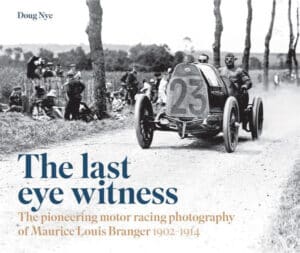Fragile memories: Incredible photographs from the earliest days of racing
Photographer Maurice Louis Branger superbly captured motor sport’s early days on brittle glass negatives. Working from those plates, Doug Nye’s new book shows the challenges of this pioneer racing era
Maurice Louis Branger
Paris-Madrid inter-city road race, 1903
No windscreen, no cockpit coaming, no protection from flying stones or airborne debris – the madcap, murderously dangerous Paris-Madrid would be the last of the top-level city-to-city road races governments would permit. Having just checked in at the stage finish line in the background, Darracq driver ‘Edmond’ and his weary riding mechanic make their way to overnight parc fermé. Their travel-stained jackets, caked and bruised faces and, above all, the state of their hands bear testament to what a challenge to human endurance – never mind the car’s – this type of pioneer racing posed.
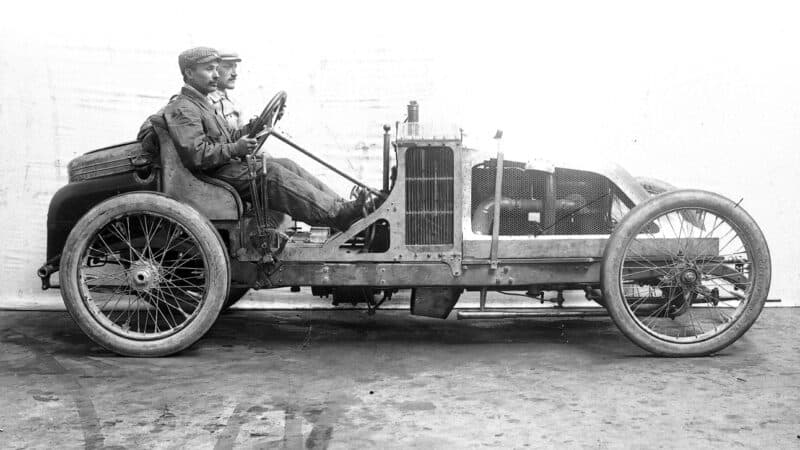
Grand Prix de l’Automobile Club de France
Grand Prix de l’Automobile Club de France, Le Mans – La Ferté-Bernard – Saint-Calais, 1906
This would prove to be a race of tyres when high temperatures caused the surface to break up, releasing stones and tar. In practice Renault experimented with the new lightweight all-metal wire wheels seen here, but fearing they would not stand up to racing stresses reverted to artillery wheels. The regulations forbade changing an entire wheel so like other manufacturers Renault tested alternatives, and just prior to the race Michelin introduced its detachable rims, allowing a car to carry inflated spares which were far faster to change. Renault fitted them on the rear wheels, a decisive factor in the victory of Ferenc Szisz.
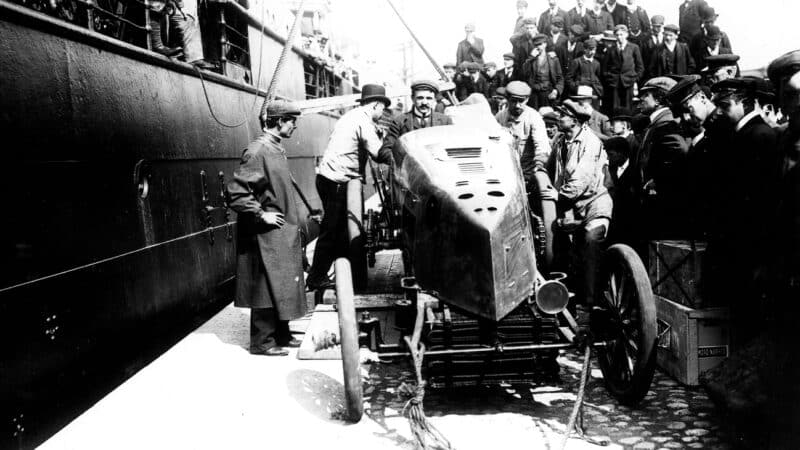
Dublin Docks
Dublin Docks, Ireland, 1903
Safely returned to firm ground, Fernand Gabriel in his Mors ‘Dauphin’, underslung gilled-tube radiator looking so vulnerable to stone and debris damage, piston-type dampers controlling jounce reaction of that beam front axle, and of course the massive rear-wheel drivechains and sprockets beyond. Among all present here is a tangible sense of excitement and anticipation, of pleasure from handling such an exotic guided missile of a racing car… all apart from Gabriel himself, just calm. There was a heavy responsibility upon his shoulders as one of the three defenders of French industrial honour – teamed with the two Panhard drivers Henri Farman and the Chevalier René de Knyff. Gabriel would race until he was 50, contesting five consecutive Le Mans 24 Hours until his last in 1928.
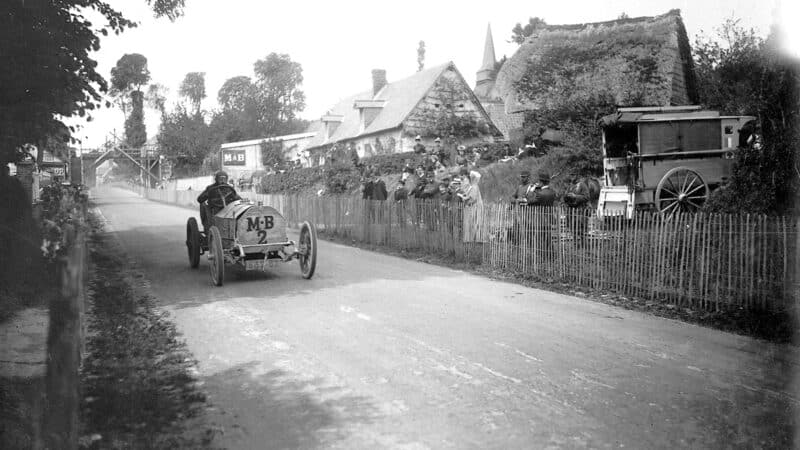
Grand Prix de l’Automobile Club de France
Maurice Louis Branger
Grand Prix de l’Automobile Club de France, Dieppe, 1907
Driver Page in his 11.9-litre Motobloc, having negotiated the blind ess-bend under the bridge at Ancourt, is pictured here pounding on through Sauchay-le-Bas. Ahead of him lie another three miles of near-straight road leading into the village of Envermeu, before seven miles on to Londinières to complete this outward leg of the long circuit. While Page’s team-mate Courtade would become the Bordeaux manufacturer’s only finisher, 11th overall, Page’s car would retire during lap five of the required 10, and Louis Pierron’s on lap nine.
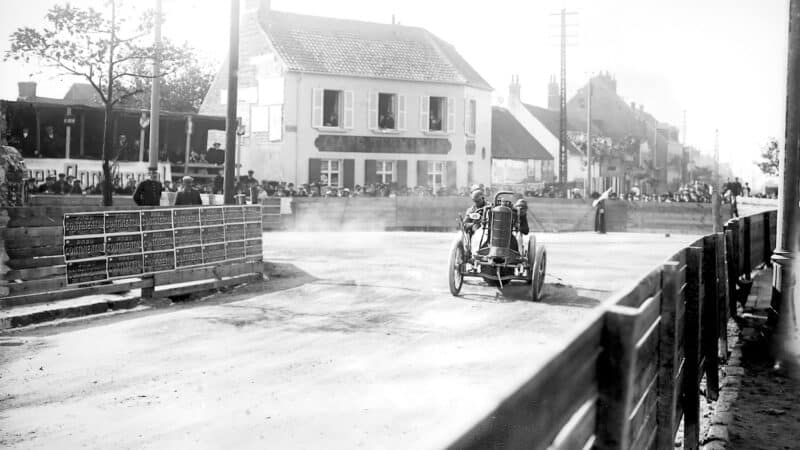
Jules Goux
Maurice Louis Branger
Jules Goux, Lion-Peugeot, Boulogne, 1910
In January 1910 it was announced that Coupe des Voiturette regulations would limit single-cylinder engines to 100mm bore, 80mm for twins and 65mm for fours. Lion-Peugeot designer Gratien Michaux’s 2803cc VX5 was a 16-degree V-twin, its regulation 80mm bore matched by an immense stroke of 280mm. The tall engine revved only to 2200rpm. Jules Goux led on race day until the car destroyed both tyres and wheels. Here at la fourche in Boulogne he demonstrates the car’s basic tyre-stressing problem – centre of gravity impractically high.
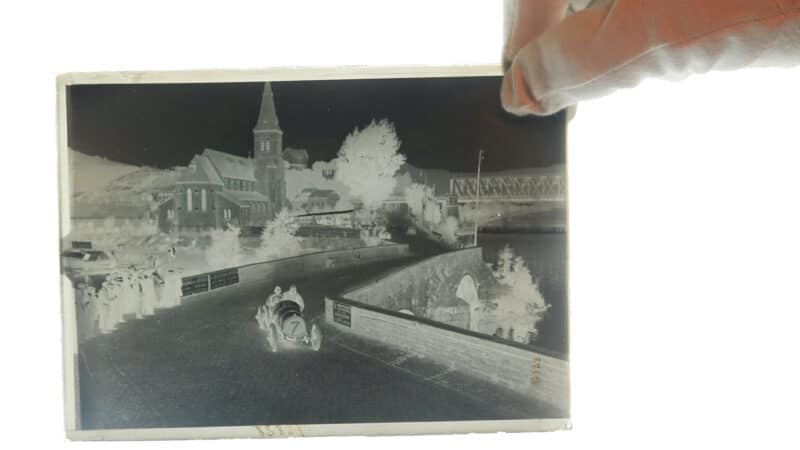
The fragile 7in x 5in glass plate negatives reproduced here were weighty items; period photographers had to haul many to every race
Maurice Louis Branger
For anyone deeply interested in the entire span of motor sporting history, it’s often a pain to see early racing photography only in grainy, soot-and-whitewash, low-resolution form. This is largely because what has been published is at best just a copy, of a copy, of a copy.
For clarity in reproducing contemporary photographs there is no better substitute for printing – or in the digital age scanning – from an original negative direct. For the past 20 years or so the GP Library Collection has included nearly 900 original and first-class glass-plate negatives recording pioneer major-league European motor sport from before World War I.
These glass plates are quite sizeable. Each one measures 18cm x 15cm and is about 2mm thick. Stack a dozen of them together and that’s quite a hefty block of glass. Imagine them in their original lightproof frames, ready to be loaded one by one into an early brass, wood and leather camera and it’s obvious the poor photographer had to sport some serious muscle to lug a day’s supply of them around a racing circuit. Of course, the truth was probably that the photographer had a paid assistant along as his sherpa… while he hiked the course light, to provide the artistry.
The author of the incredible images reproduced here was Maurice Louis Branger (pronounced ‘Brawn-zhay’). His forenames have often been quoted hyphenated, but his birth and marriage certificates demonstrate otherwise.
Portly and bushy-moustachioed, he built much of his reputation for a competent composition through photographing everyday Parisian life, but early big-time motor sport was a great personal interest to him. His pictures graced the pages of many specialist European journals.
Born in Fontainebleau in 1874, he began work as a photographer in 1895. He ‘shot’ motor sport from 1902 on, and founded his Photopresse photo reportage agency at 5 Rue Cambon, just off the Tuileries Gardens in Paris, in 1905.
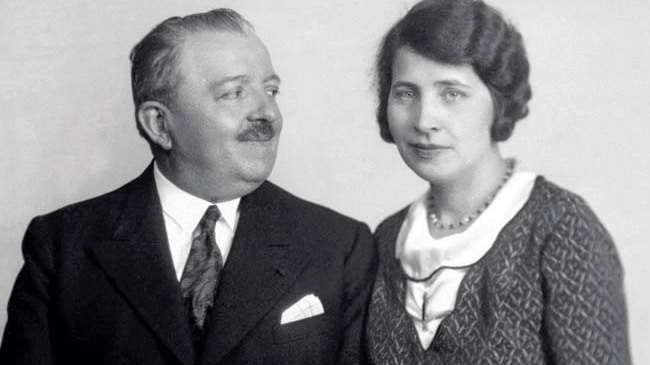
Branger with second wife Jeanne. As well as racing, his agency covered much of French life
Maurice Louis Branger
Another early star photographer of the racing scene was Belgian-born Louis Meurisse who actually worked for Branger before going independent and rubbing shoulders most notably with the doyen of Edwardian-era British reporters, W.F. Bradley. In truth we cannot know for sure how many surviving ‘Branger’ images were actually captured by Meurisse, but the main man himself was evidently well known and well liked amongst the pre-First World War racing fraternity.
In 1913 he diversified further, as one of the rare photographers to cover the First Balkan War. He commissioned fellow photographers to visit that conflict, and from 1914 he and his colleagues became World War I photographers. Postwar he was no longer active on the racing scene.
But as you can see on these pages, Branger’s record of motor racing’s reality from 1902-14 preserves a haunting quality of that long-gone era. It’s one during which racing drivers divided between monied sporting gentlemen and purely professional artisan workers simply doing their day job.
To hold one of these original glass-plate negs today is to marvel at its simple survival over more than 100 years. Then there’s the sense that this frail pane was actually right there on that actual day, slotted into Branger’s camera, vibrating to the throb of that massive racing engine as the car in question bellowed by.
Here in your hand is what amounts to being that fleeting instant of racing history’s last eye witness…
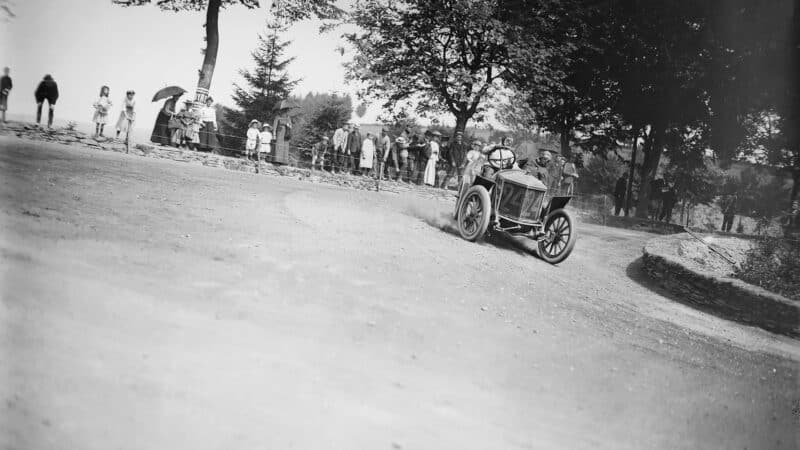
Circuit des Ardennes
Maurice Louis Branger
Circuit des Ardennes, 1907
This year, two Ardennes races were arranged, one for Kaiserpreis-type vehicles before an event for Grand Prix machinery. In Germany, motoring enthusiast Kaiser Wilhelm had offered his trophy for a race for “medium-power cars, nominally of the touring type”. The organisers hoped this less-costly category would attract a strong industry entry but that did not materialise. The race was contested mainly between two Belgian marques, Pipe and Minerva. Anglo-Irishman Kenelm Lee Guinness, here wheeling his Minerva into a tight turn, set a record lap before being passed by team-mates John Moore-Brabazon and ‘Frits’ Koolhoven, the three Minervas finishing in that order.
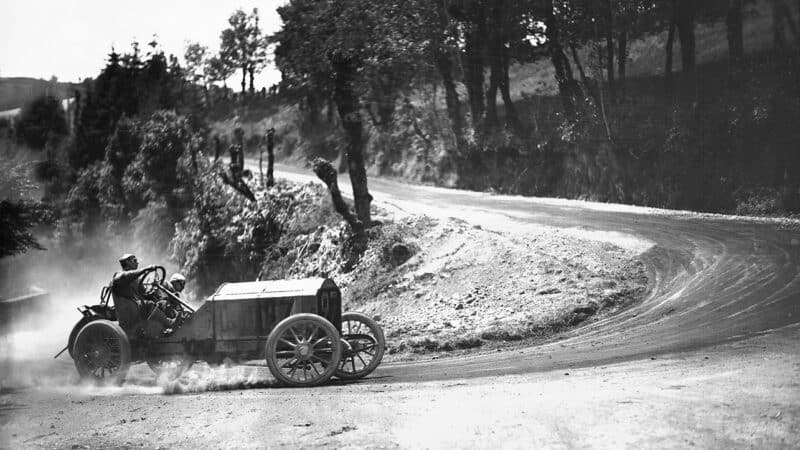
Gordon Bennett Cup
Maurice Louis Branger
Gordon Bennett Cup – French Eliminating Trials, 1905
Determination, dust, grit and guts. Arthur Duray in De Dietrich No27 contests the 1905 French Eliminating Trials for the Gordon Bennett race – four laps of the 85-mile Auvergne circuit, total 341.4 miles – for a place in France’s three-car Cup team. In his 17-litre 130hp machine he finished third overall behind the Richard-Brasiers of winner Léon Théry and second-place man Gustave Caillois. Théry averaged 44.9mph for the total distance and set fastest lap at 50mph – you’d be doing well to match that on these roads today.
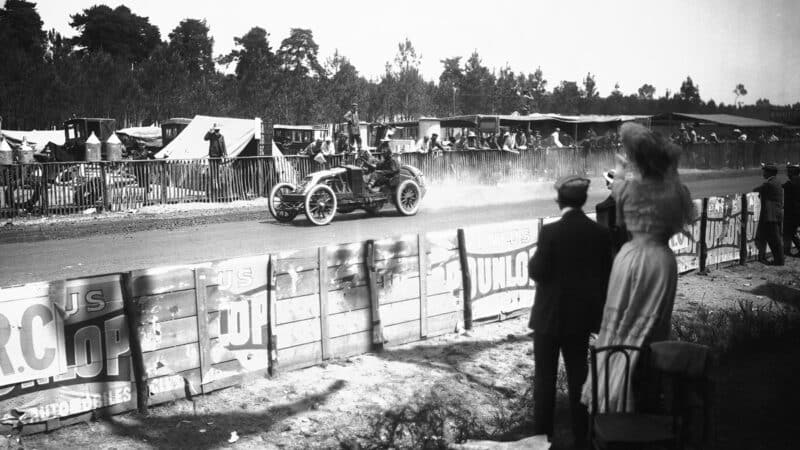
Grand Prix de l’Automobile Club de France
Maurice Louis Branger
Grand Prix de l’Automobile Club de France, La Sarthe circuit, Le Mans – Saint-Calais – La Ferté-Bernard, 1906
The fast, the fans and the fashionable – Szisz and mechanic Marcel Marteau in their ultimately victorious factory Renault Type AK thumping past Branger and his trusty camera. To provide some measure of crowd control around its long circuit the Automobile Club de la Sarthe installed 40 miles of board fencing, as well as the chestnut palings seen here. It left few stones unturned to make the ACF’s inaugural Grand Prix a success. The ‘Great Prize’ of 45,000 francs fell to Renault, representing almost £264,000 today. Never mind racing for national glory, the new sport offered a solid-gold business opportunity…
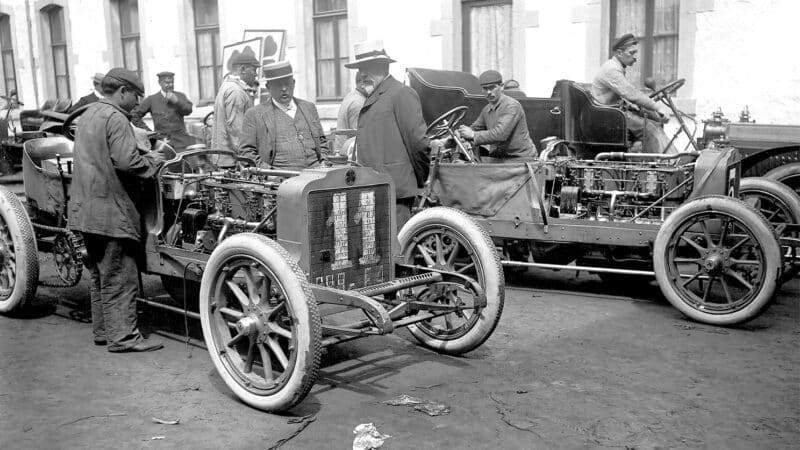
Circuit des Ardennes
Maurice Louis Branger
Circuit des Ardennes, 1906
This study at scrutineering gives us a detailed view of two of the 11.7-litre four-cylinder Brasier team cars entered for drivers Jules Barillier, Paul Baras (No11 here), ‘Pierry’ and Bablot, tended by works mechanics and discussed by the straw-hatted gentry. Baras suffered an embarrassingly early retirement, a stub-axle breakage sending him off the road. Pierry followed on lap two, having taken more than a minute longer than Otto Salzer’s fleet Mercedes to complete lap one, and Paul Bablot in lap five. Despite Barillier’s fourth place, it was not a great promotional success for the marque; without fresh racing wins to impress wealthy customers the company reached the brink of bankruptcy.
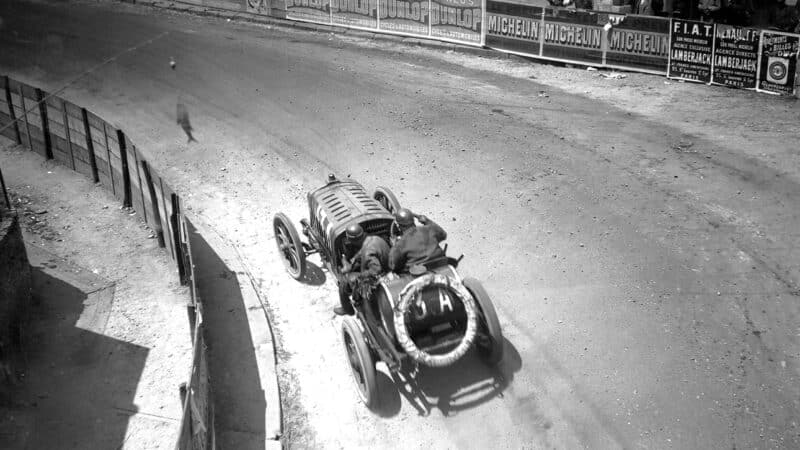
Grand Prix de l’Automobile Club de France
Maurice Louis Branger
Grand Prix de l’Automobile Club de France, La Sarthe circuit, Le Mans – Saint-Calais –La Ferté-Bernard, 1906
Surely one of Branger’s most creative motor racing images, looking down past that angling-shop sign upon No3A – crash-helmeted Albert Clément in the 12.8-litre 160hp Clément-Bayard. Albert –just 22 – was a rising star in top-level motor sport. This first GP was run in two parts, a total 384.45 miles on each of two days, totalling 769.9 miles. Young Albert finished second overall on aggregate, but Clément-Bayard’s failure to match Renault in adopting detachable-rim wheels probably cost it victory overall.
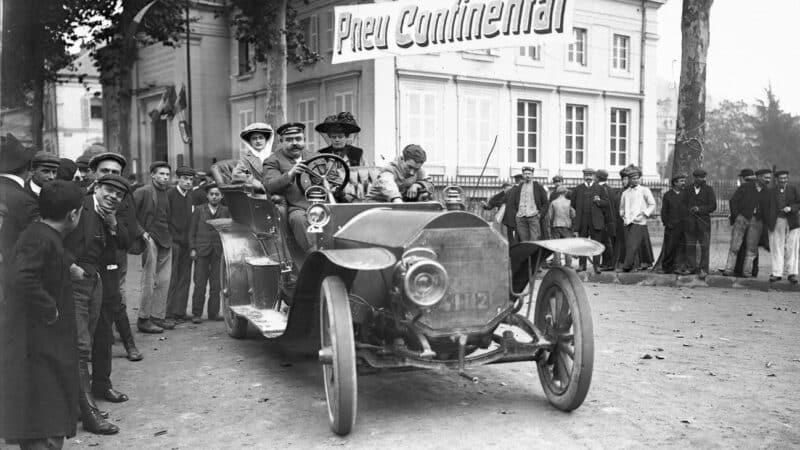
Château-Thierry
Maurice Louis Branger
Château-Thierry, 1908
The hierarchy in contemporary motor sport reflected society, from aristocracy and extreme wealth to working-class manufacturer employees rising to sporting supercar status as drivers. This lovely image at the Château-Thierry hillclimb features the imposing 60hp Mercedes owned by French noble Ferdinand, Duc de Montpensier, car enthusiast and grandson of King Louis Philippe I. The driver is Paul ‘Le Gros’ (‘Fatty’) Faure, well-known chauffeur/competition driver, hired by monied clients via Mercedes. The previous year he had set FTD here in the Duc’s earlier Mercedes; this time he won his six-cylinder class, at 1min 14sec over the brief 1km climb.
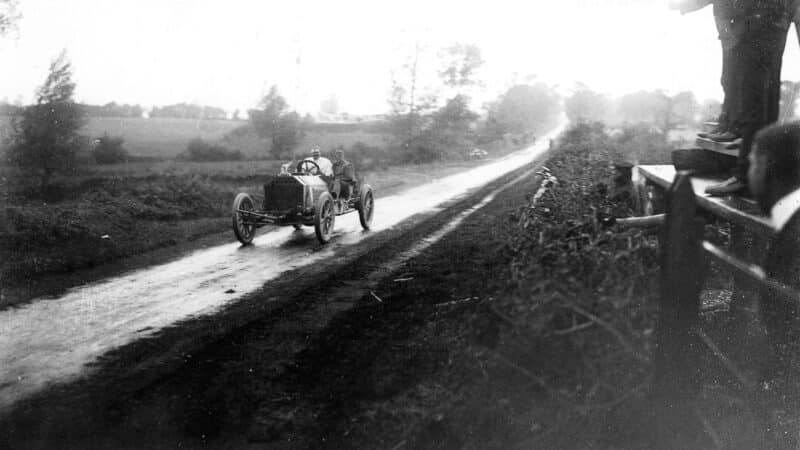
IV Gordon Bennett Cup
Maurice Louis Branger
IV Gordon Bennett Cup, Ballyshannon, County Kildare, Ireland, 1903
Irish weather beset the Gordon Bennett Cup race as a no doubt damp and disappointed Branger experienced here, until the throbbing beat of a 13.7-litre four-cylinder engine could be heard, approaching over that distant mist-shrouded brow. And here he has just triggered his camera, to capture the even wetter S.F. Edge and his doughty riding mechanic booming by in the Shamrock Green No1 Napier. On the dryer sections of the long dual circuit the big car’s appetite for tyres just became unsupportable, Edge finishing slowest and last of the dozen starters, and then being disqualified for receiving a push-start when leaving a control point.
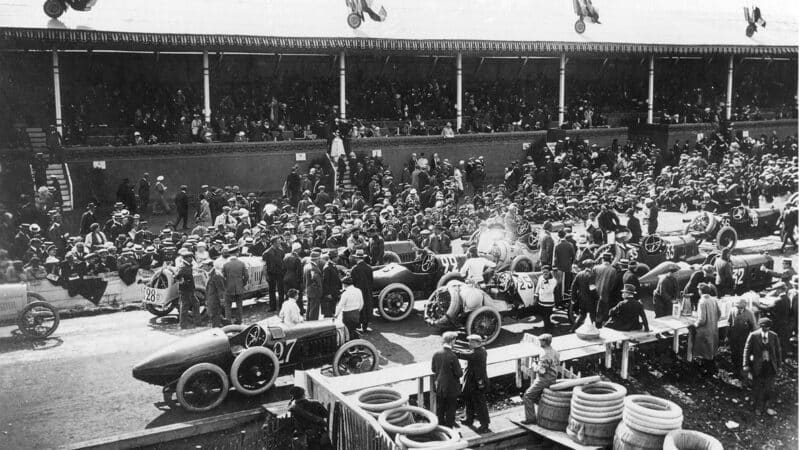
V Grand Prix de l’Automobile Club de France
V Grand Prix de l’Automobile Club de France, Lyon – Givors, 1914
A modern racing era had been fully established by 1914, but soon it would be tragically shattered by the outbreak of World War I seven weeks later. Here the starting grid has lined up. From left: No27 is Antonio Fagnano’s Fiat S57; No28, German race winner Christian Lautenschlager’s factory Mercedes; 22, Jean Porporato’s Italian Nazzaro; 25, Briton Thomas Clarke’s Pic-Pic; 33, Henri Juvanon’s Th Schneider; 32, Victor Rigal’s tulip-tailed Peugeot L45; and 36, Guinness’s Sunbeam, whose engine would eventually wilt.
The Last Eye Witness: The Pioneering Motor Racing Photography of Maurice Louis Branger 1902-1914
by Doug Nye (Porter Press, £195) is available now
